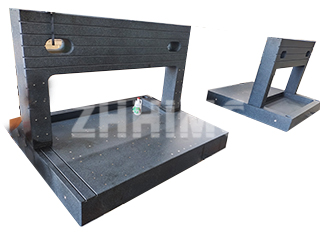Granite bases, valued for their high rigidity, low thermal expansion, and excellent resistance to corrosion, are widely used in precision instruments, optical systems, and industrial metrology applications. Their dimensional accuracy directly affects assembly compatibility, while proper cleaning and maintenance determine long-term stability and measurement precision. Below, we outline the principles of dimensional definition and best practices for cleaning and upkeep.
1. Dimensional Definition – Function-Oriented Precision Design
1.1 Establishing Fundamental Dimensions
The basic parameters of a granite base—length, width, and height—should be determined based on the overall equipment layout. The design must prioritize functional requirements and spatial compatibility:
-
For optical instruments, additional clearance must be allowed to avoid interference.
-
For high-precision measurement bases, lower heights help reduce vibration transmission and improve stability.
ZHHIMG® follows the principle of “function first, compact structure”, ensuring cost efficiency without compromising performance.
1.2 Defining Critical Structural Dimensions
-
Mounting Surface: The contact surface must fully cover the supported equipment base, avoiding localized stress concentrations. Rectangular devices require slightly oversized surfaces for adjustment, while circular equipment benefits from concentric mounting surfaces or locating bosses.
-
Positioning Holes: Threaded and locating holes must match the equipment’s connectors. A symmetrical distribution enhances torsional rigidity, while adjustment holes allow for fine calibration.
-
Weight-Reduction Grooves: Designed in non-load-bearing areas to minimize mass and material costs. Shapes (rectangular, circular, or trapezoidal) are optimized based on stress analysis to preserve rigidity.
1.3 Tolerance Control Philosophy
Dimensional tolerances reflect the machining precision of the granite base:
-
High-precision applications (e.g., semiconductor manufacturing) demand flatness controlled to the micron level.
-
General industrial use allows for slightly looser tolerances.
ZHHIMG® applies the principle of “strict on critical dimensions, flexible on non-critical dimensions”, balancing accuracy with manufacturing cost through advanced processing and measurement techniques.
2. Cleaning and Maintenance – Ensuring Long-Term Reliability
2.1 Daily Cleaning Practices
-
Dust Removal: Use a soft brush or vacuum cleaner to eliminate particles and prevent scratches. For stubborn stains, a lint-free cloth dampened with distilled water is recommended. Avoid corrosive cleaning agents.
-
Oil and Coolant Removal: Immediately wipe contaminated areas with isopropyl alcohol and dry naturally. Oil residues may clog pores and affect moisture resistance.
-
Metal Protection: Apply a thin layer of anti-rust oil to threaded and locating holes to prevent corrosion and maintain assembly integrity.
2.2 Advanced Cleaning for Complex Contamination
-
Chemical Exposure: In case of acid/alkali contact, wash with a neutral buffer solution, rinse thoroughly with distilled water, and allow 24 hours for complete drying.
-
Biological Growth: If mold or algae appear in humid environments, spray with 75% alcohol, brush gently, and apply UV sterilization. Chlorine-based cleaners are prohibited to avoid discoloration.
-
Structural Repair: Micro-cracks or edge chipping should be repaired with epoxy resin, followed by grinding and re-polishing. Post-repair, dimensional accuracy must be reverified.
2.3 Controlled Cleaning Environment
-
Maintain temperature (20±5°C) and humidity (40–60% RH) during cleaning to prevent expansion or contraction.
-
Replace cleaning tools (cloths, brushes) regularly to avoid cross-contamination.
-
All maintenance activities should be documented for full lifecycle traceability.
3. Conclusion
The dimensional accuracy and cleaning discipline of a granite base are essential to its performance and lifespan. By adhering to function-oriented design principles, optimized tolerance allocation, and a systematic cleaning protocol, users can ensure long-term stability, reliability, and measurement accuracy.
At ZHONGHUI Group (ZHHIMG®), we combine world-class granite materials, ISO-certified production, and decades of craftsmanship to deliver granite bases that meet the most demanding standards in semiconductor, metrology, and precision engineering industries.
Post time: Sep-29-2025

